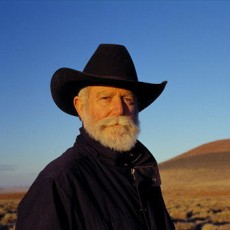 “Turrell is one of the most multifaceted artists of our time.” — Interview Magazine
“Turrell is one of the most multifaceted artists of our time.” — Interview Magazine
James Turrell was born in Los Angeles in 1943. His undergraduate studies at Pomona College focused on psychology and mathematics; only later, in graduate school, did he pursue art. He received an MFA in art from the Claremont Graduate School in Claremont, Calif. Turrell’s work involves explorations in light and space that speak to viewers without words, impacting the eye, body, and mind to heighten awareness.
“I want to create an atmosphere that can be consciously plumbed with seeing,” says the artist, “like the wordless thought that comes from looking in a fire.”
Informed by his studies in perceptual psychology and optical illusions, Turrell’s work allows us to see ourselves “seeing.” Whether harnessing the light at sunset or transforming the glow of a television set into a fluctuating portal, Turrell’s art places viewers in a realm of pure perceptual experience. His fascination with the phenomena of light is ultimately connected to a very personal, inward search for mankind’s place in the universe. Influenced by his Quaker faith, which he characterizes as having a “straightforward, strict presentation of the sublime,” Turrell’s art prompts greater self-awareness through a similar discipline of silent contemplation, patience, and meditation.
His background in aircraft construction and flight navigation, together with a rigorous knowledge of optics, eye physiology and perceptual psychology, have each informed his work over the last four decades.
In 1966, Turrell rented the former Mendota Hotel in Ocean Park, California: sealing the building from the sound and light outside, he experimented with projected light, gradually introducing shafts of moon and sunlight into the spaces. This important period of experimentation and development provided the basis necessary for all subsequent works.
Following his first international solo exhibition aged 33 at the Stedelijk Museum in Amsterdam, Turrell has continued to exhibit in major museums internationally.
In 1984 he was awarded the prestigious ‘genius’ award – the Katherine T. and John D. MacArthur Foundation Fellowship; the Chevalier des Arts et des Lettres, France in 1991; the Friedrich Prize, Germany in 1992; an Honorary Doctorate from the Royal College of Art, London in 2003; and membership of the esteemed American Academy of Arts and Sciences in 2004.
His work is represented in numerous public collections, including the Tate Modern in London, the Los Angeles County Museum of Art, the Walker Art Center in Minneapolis, the Guggenheim in New York and the de Young Museum in San Francisco.
A Turrell retrospective will be on view in 2013 at the Los Angeles County Museum of Art, Solomon R. Guggenheim Museum in New York and the Museum of Fine Art in Houston. In the meantime, the artist is appearing in a number of shows, including an installation at this summer’s Venice Biennale, and his first solo exhibition in Russia.
”I want to address the light that we see in dreams,” he says. ”It’s not about filling a space with stuff. And light is sensual. Anything sensual, while it can attract you toward the spiritual, can hold you from it, too; it can keep you in the physical world, and that’s an explicit part of my work, which I think is sensual and emotional in the way that music is sensual and emotional.” – James Turrell in The New York Times


